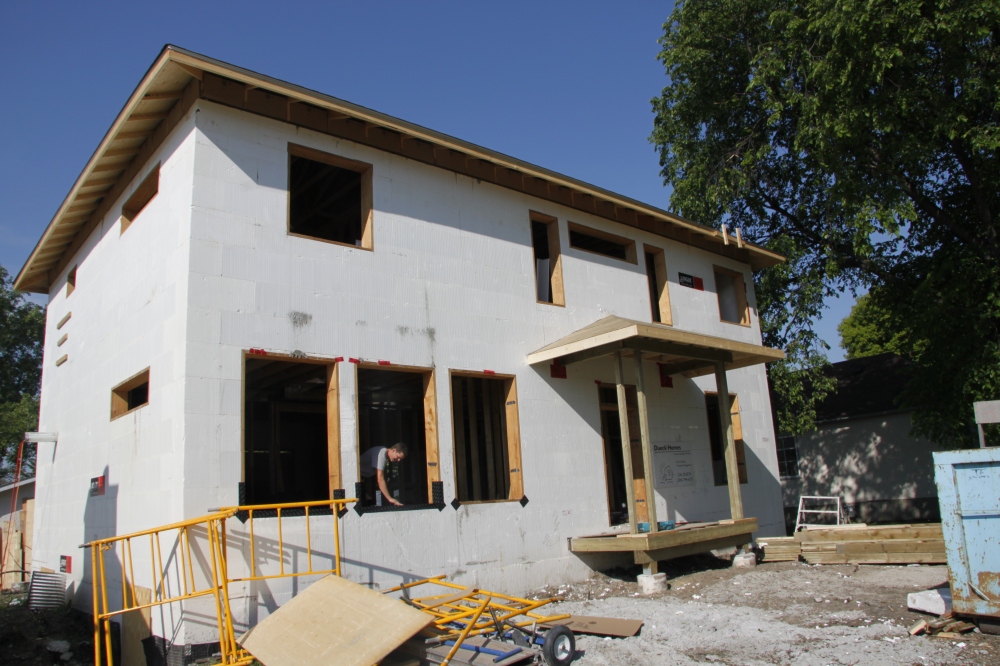You’ve finally moved into your dream home — the furniture is in place, the curtains are hung, and everything looks perfect. But have you ever stopped to think about the air you’re breathing? That “new home smell” might seem fresh, but it can contain hidden pollutants that affect your family’s health.
At Dueck Builders, we’re not just custom home builders in Winnipeg — we’re passionate about creating sustainable, energy-efficient homes that ensure your indoor air is clean, safe, and healthy. Let’s explore what could be in your indoor air and how thoughtful design and building choices can make a big difference.
What’s in Your Indoor Air?
Volatile Organic Compounds (VOCs)
Volatile Organic Compounds, or VOCs, are chemicals that easily evaporate at room temperature. They’re found in everyday building materials and household products like paints, adhesives, sealants, carpeting, and furniture.
These compounds contribute to poor indoor air quality and can cause headaches, nausea, dizziness, and, with prolonged exposure, more serious health issues such as lung damage or cancer.
At Dueck Builders, we take these risks seriously. That’s why we use low-VOC or zero-VOC paints, glues, and caulks in every project, helping our clients enjoy homes that are both beautiful and healthier to live in.
Thanks to Custom Made for this handy info-graphic.
Radon and Formaldehyde: The Hidden Health Risks
Radon: The Silent Threat Beneath Your Home
Radon is a naturally occurring radioactive gas that seeps into homes from the ground through cracks in foundations or gaps around pipes. You can’t see, smell, or taste it — but long-term exposure can be dangerous.
According to the Canadian Cancer Society, radon is the second leading cause of lung cancer after smoking, contributing to roughly 16% of lung cancer deaths in Canada each year.
At Dueck Builders, we incorporate radon-resistant construction techniques and can include radon testing and mitigation systems to keep your indoor air safe.
Formaldehyde: A Common but Overlooked Pollutant
Formaldehyde is found in engineered wood products like OSB (oriented strand board), some insulation materials, and certain furniture or cabinetry. Prolonged exposure can irritate the eyes, nose, and throat, and long-term exposure has been linked to increased cancer risks.
To protect our homeowners, Dueck Builders:
-
Install sub-slab depressurization systems to safely vent radon outside.
-
Avoid materials with high urea-formaldehyde content in cabinetry, flooring, and insulation.
-
Design HVAC systems that balance indoor air pressure, reducing radon infiltration.
-
Never use OSB inside the vapour barrier, eliminating a common source of formaldehyde off-gassing.

Microplastics: The Emerging Threat in Your Indoor Air
Microplastics are tiny plastic particles that come from synthetic fabrics, household dust, and furniture coatings. Studies suggest that inhaling microplastics may contribute to respiratory problems and other health issues.
Ways to reduce microplastic exposure in your home:
-
Choose natural fiber materials for carpets, rugs, and upholstery.
-
Use HEPA air filters in your HVAC system to trap airborne microplastics.
-
Minimize synthetic cleaning products that release microplastic particles.
-
Opt for wood or fiberglass windows instead of PVC.
-
Select eco-friendly, low-VOC paints like Farrow & Ball.
By making mindful material choices and using proper filtration, you can greatly reduce microplastic exposure in your home.
How to Improve Indoor Air Quality in Your Home
Avoiding indoor air problems is easier when you build your home the right way from the start. Here’s how Dueck Builders ensures the healthiest indoor air possible:
1. Choose Sustainable, Non-Toxic Materials
We use low-emission, non-toxic materials in every home. When possible, select natural products such as wood, stone, and low-VOC finishes. Using ICF (Insulated Concrete Form) for basement walls can prevent mold growth and improve long-term air quality.
2. Prioritize Proper Insulation and Ventilation
Healthy homes need to breathe correctly. Our homes are designed with ERVs (Energy Recovery Ventilators) to cycle out stale air while maintaining optimal humidity. Paired with well-installed air and vapour barriers, this protects against mold, radon, and moisture-related issues.
3. Use Hard-Surface Flooring
Opting for hardwood, tile, or polished concrete instead of carpet reduces VOCs and microplastics, while making cleaning easier. Small details like these have a big impact on indoor air quality.
These often-overlooked elements make a significant difference in the health and livability of your home. When building a new home, you get one opportunity to get it right — and at Dueck Builders, we ensure every detail supports your family’s wellbeing.

An ICF home we built 4 years ago in Elmwood area.
Breathe Easier in a Healthier Home
At Dueck Builders, a truly sustainable home is one that supports your family’s health as much as it benefits the environment. If you’re planning a new home or renovation in Winnipeg, let’s talk about how we can build a cleaner, healthier, and more sustainable living space for you.
📞 Call us at 204-806-0616
🌐 Visit our website to learn more!

